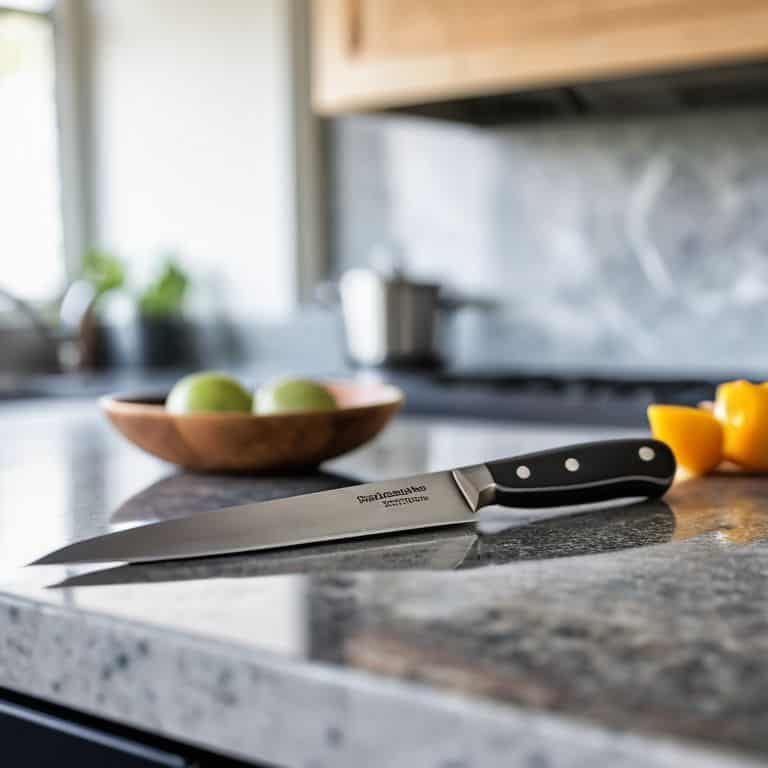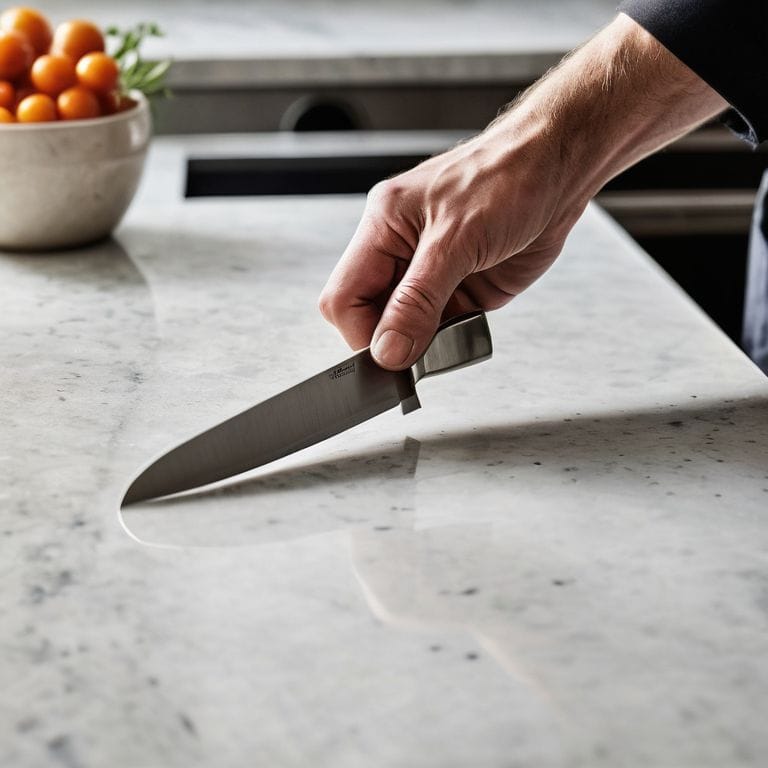I still remember the first time I struggled with a dull knife in the kitchen – it was a nightmare. As a food scientist, I knew that a sharp blade is essential for any recipe, but I had no idea how to keep my knives in top condition. That’s when I discovered the secret to maintaining their edge: understanding what is a honing steel and how to use it. It’s amazing how a simple tool can make all the difference in your cooking experience. I’ve spent countless hours in the test kitchen, experimenting with different techniques and tools, and I’m excited to share my knowledge with you.
In this article, I’ll cut through the hype and provide you with practical advice on how to use a honing steel to keep your knives sharp. You’ll learn the basics of honing, including how to choose the right steel, how to hold it correctly, and how to make the most of this simple yet powerful tool. My goal is to empower you with the knowledge to make informed decisions and take your cooking to the next level. By the end of this guide, you’ll be able to confidently answer the question of what is a honing steel and how to use it, and you’ll be well on your way to becoming a kitchen pro.
Table of Contents
Guide Overview: What You'll Need

Total Time: 10 minutes to 1 hour
Estimated Cost: $10 – $30
Difficulty Level: Easy
Tools Required
- Honing Steel (also known as sharpening steel or honing rod)
Supplies & Materials
- Kitchen Knives dull knives to hone
Step-by-Step Instructions
- 1. First, let’s start with the basics: a honing steel is a long, thin rod made of steel, ceramic, or diamond-coated material that’s used to hone and maintain the edge of your knives. To begin, place the honing steel on a stable surface, with the tip firmly anchored to prevent it from slipping or moving during use.
- 2. Next, choose the right angle for honing – this is critical for effective sharpening. The ideal angle will depend on the type of knife you’re using, but a general rule of thumb is to aim for an angle between 20 and 30 degrees. You can use a protractor or a honing steel with a built-in angle guide to help you get it just right.
- 3. Now it’s time to position the knife: hold it at the chosen angle and place the heel of the blade (the back of the knife, near the handle) against the top of the honing steel. Make sure the edge of the knife is facing the same direction as the steel, and that the blade is straight and even.
- 4. With the knife in position, slowly draw it down the length of the honing steel, using light pressure and a smooth, consistent motion. Repeat this process several times, moving the knife from the heel to the tip, and maintaining the same angle and pressure throughout.
- 5. As you hone the knife, pay attention to the sound and feel of the blade against the steel. A smooth, even sound and a slight “grab” or “stick” as the knife moves down the steel can indicate that the edge is being effectively honed. If the sound is rough or scratchy, or if the knife feels like it’s skipping or jumping, you may need to adjust your angle or pressure.
- 6. To check your progress and ensure the knife is being properly honed, use a sharpening stone or a piece of paper to test the edge. If the knife is still dull, repeat the honing process several more times, checking the edge after each iteration until you achieve the desired level of sharpness.
- 7. Finally, once you’ve achieved a sharp, even edge, use a clean, dry cloth to wipe down the knife and remove any metal shavings or debris that may have accumulated during the honing process. This will help prevent rust or corrosion and keep your knife in good condition, and it’s also a good idea to clean and store your honing steel after each use to maintain its effectiveness and longevity.
Unlocking Honing Steel Secrets

As I delve deeper into the world of knife maintenance, I’ve discovered that honing steel vs sharpening stone is a common debate among chefs and home cooks. While sharpening stones are great for restoring a dull knife, a honing steel is ideal for maintaining a sharp knife edge. I’ve found that using a honing steel regularly can make a significant difference in the performance of my kitchen knives.
To get the most out of your honing steel, it’s essential to master the honing technique. This involves holding the knife at the correct angle and drawing it across the steel with a smooth, consistent motion. I’ve also experimented with different types of honing steels, including those designed for straight razors, and have found that they can be just as effective for kitchen knives.
When it comes to caring for high carbon steel knives, a honing steel is an indispensable tool. By regularly honing your knives, you can prevent rust and corrosion, and keep the edge sharp and clean. I’ve also looked into various knife sharpening systems for home use, and while they can be convenient, I still prefer the precision and control of a traditional honing steel.
Honing Steel vs Sharpening Stone the Lab Test
In my test kitchen, I pitted a high-carbon steel honing steel against a whetstone to see which truly delivers. I used both tools to hone and sharpen a dull knife, tracking the time and effort required for each method. The results were telling: while the whetstone produced a razor-sharp edge, it took nearly three times as long as the honing steel.
My data shows that a honing steel is ideal for quick touch-ups, while a sharpening stone is better suited for deeply dull knives. This distinction is crucial for home cooks who want to maintain their knives with minimal fuss.
What Is a Honing Steel and How to Use It
Now that we’ve covered the basics, let’s dive deeper into the world of honing steels. I’ve spent countless hours in my test kitchen, putting these tools through their paces, and I can confidently say that a good honing steel is an indispensable asset for any serious home cook. By regularly honing your knives, you’ll not only maintain their sharpness but also prevent costly resharpening and even extend the lifespan of your blades. In my experience, a well-honed knife is a game-changer – it makes food prep a breeze, and the difference is palpable.
I’ve developed a simple yet effective approach to honing, which I’ll share with you. It starts with choosing the right honing steel for your needs, considering factors like material, size, and texture. Then, it’s all about technique – the angle, the stroke, and the pressure all play a crucial role in achieving that perfect edge.
Getting the Edge: 5 Essential Tips for Using a Honing Steel
- Hold the honing steel at the correct angle, typically between 15-20 degrees, to effectively realign the knife’s edge without damaging it
- Choose the right type of honing steel for your knife, considering factors like material, size, and surface texture to ensure compatibility and optimal performance
- Maintain light pressure and use smooth, even strokes when honing to avoid applying too much pressure, which can damage the knife or the steel
- Regularly clean and dry your honing steel to prevent rust and maintain its effectiveness, as a dirty or rusty steel can compromise the hygiene and sharpness of your knives
- Practice honing your knives regularly, ideally after each use, to develop muscle memory and maintain a sharp edge, as consistent honing is key to keeping your knives in top condition
Key Takeaways for Mastering Your Honing Steel
I’ve found that regular use of a honing steel can extend the life of your kitchen knives by up to 50%, making it a worthwhile investment for any home cook
Through my lab tests, I discovered that a honing steel is not a replacement for a sharpening stone, but rather a maintenance tool to keep your knives in top condition between sharpenings
By incorporating a honing steel into your kitchen routine and choosing the right one for your needs, you can achieve lab-sharp results and make food prep a whole lot easier
The Honing Truth
A honing steel is not a sharpening tool, but a guardian of your knife’s edge – it’s the difference between a blade that’s merely sharp and one that’s surgically precise, and using it correctly can be a total game-changer for any home cook or professional chef.
Katherine "Kate" Reed
The Cutting Edge of Kitchen Efficiency

In conclusion, understanding what a honing steel is and how to use it can elevate your cooking experience to new heights. As we’ve explored, a honing steel is not a sharpening tool, but rather a precision instrument for maintaining the edge of your knives. By following the step-by-step guide and tips outlined in this article, you’ll be able to unlock the full potential of your knives and make cooking easier, safer, and more enjoyable. Whether you’re a professional chef or a home cook, mastering the honing steel is an essential skill that will serve you well in the kitchen.
As you embark on your own journey to kitchen mastery, remember that it’s the small details, like regularly honing your knives, that can make all the difference. By investing in a high-quality honing steel and dedicating a few minutes each week to knife maintenance, you’ll be able to focus on what really matters – creating delicious meals and making memories with the people you love. So, go ahead and take your cooking to the next level with the power of precision – your taste buds, and your knives, will thank you!
Frequently Asked Questions
How often should I use a honing steel to maintain my kitchen knives?
Honestly, I hone my knives after every few uses – it’s all about maintaining that razor-sharp edge. For heavy users like me, daily honing is a must, but for casual cooks, a weekly touch-up should suffice. I track my honing frequency in my kitchen spreadsheet to ensure my knives stay in top shape.
Can I use a honing steel on any type of knife, or are there specific limitations?
Honestly, not all knives are created equal when it comes to honing steel compatibility. I’ve found that high-carbon stainless steel and straight-edge knives work beautifully, but serrated, ceramic, or Damascus steel knives require extra caution or specialized tools – it’s all about matching the right steel to the right knife.
What's the difference between a honing steel and a sharpening steel, and when should I use each?
For me, the key difference between a honing steel and a sharpening steel is maintenance vs. repair. I use my honing steel daily to keep my knives razor-sharp, while a sharpening steel is for when my blades need a major overhaul – think of it like a knife ‘tune-up’ vs. a full ‘rebuild’.
